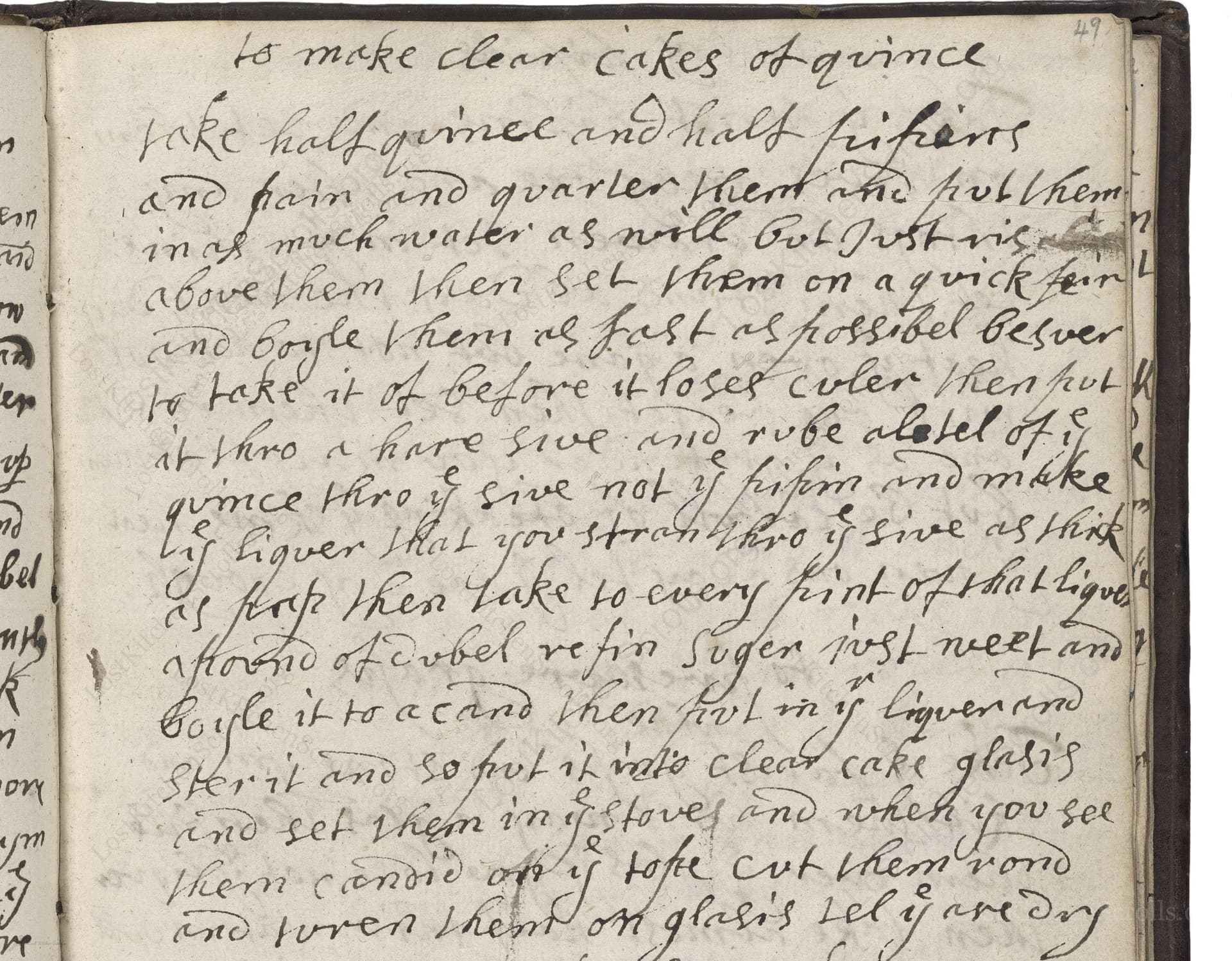To Make Clear Cakes Of Quince
From the treasured pages of Medicinal and cookery recipes by John King
Written by John King

To Make Clear Cakes Of Quince
"take half quince and half pipins and pair and quarter them and put them in as much water as will but just rise above them then set them on a quick fire and boyle them as fast as possibel besure to take it of before it loses coler then put it thro a hare sive and rube all of ye quince thro ye sive not ye pipins and make ye liquer that you strain thro ye sive as thick as pap then take to evry pint of that liquer a pound of dubel refin suger just meet and boyle it to a cand then put in ye liquer and ster it and so put it into clear cake glasis and set them in stoves and when you see them candid on ye tope cut them rond and toren them on glasis til ye are dry"
Note on the Original Text
The recipe uses period spelling and grammar—'boyle' for 'boil,' 'liquer' for 'liquor' (meaning liquid or puree), 'dubel refin suger' for 'double-refined sugar.' Quantities are given per pint, and terms like 'to a cand' refer to boiling until the syrup reaches the candy stage. Instructions focus on tactile and visual clues—'before it loses coler,' 'as thick as pap'—typical of early modern recipes. Such recipes presume the reader already has some kitchen knowledge, so instructions are brisk and rely on sensory experience rather than exact times or temperatures. This was a common approach in household manuscripts of the period.

Title
Medicinal and cookery recipes by John King (1675)
You can also click the book image above to peruse the original tome
Writer
John King
Era
1675
Publisher
Unknown
Background
A delightful journey into the kitchens of the 17th and early 18th centuries, this collection, attributed to John King, brims with time-honored recipes, culinary wisdom, and flavors that once graced historic tables.
Kindly made available by
Folger Shakespeare Library
This recipe hails from the early 18th century, nestled in the period approximately between 1625 and 1725. It originates from the collection of John King, a figure who likely compiled household and culinary advice reflective of gentry or well-to-do households in England. Quinces—prized for their fragrance and intense flavor—were often transformed into conserves or clear 'cakes' (confections similar to jellied fruit pastes), sometimes presented as gifts or served with sweetmeats. Their combination with apples (or 'pipins') showcases both the inventive nature and practical resourcefulness of English preservation and confectionery traditions.

Back in the day, cooks relied on open hearths or quick-burning fires to control the cooking temperature. Large cauldrons or copper jam pans were used for boiling fruit. Sifting was done with a horsehair sieve, allowing for a smoother puree. The mixture was boiled to the candy stage in thick-bottomed pans, then poured into glass or perhaps tin 'cake glasses'—shallow molds designed to let the jelly set and become translucent. Drying would occur in a 'stove,' which is a warm, dry airing cupboard or a very low oven, and finishing was done on glass or wooden trays, sometimes on paper or thin slats.
Prep Time
30 mins
Cook Time
45 mins
Servings
10
We've done our best to adapt this historical recipe for modern kitchens, but some details may still need refinement. We warmly welcome feedback from fellow cooks and culinary historians — your insights support the entire community!
Ingredients
- 1 lb quinces (peeled, cored, quartered)
- 1 lb tart cooking apples (peeled, cored, quartered; e.g. Bramley or Granny Smith)
- Water (enough to just cover the fruit)
- 2 lbs double-refined white sugar (ultrafine caster sugar or superfine sugar is a good substitute)
Instructions
- Take equal parts quinces and cooking apples (such as Bramley or Granny Smith), peel, core, and quarter them.
- Place them in a pot and add just enough water to cover them.
- Set over high heat and boil rapidly until the fruit is soft but still brightly colored—avoid overcooking to preserve the color.
- Strain through a fine mesh sieve, pressing all the quince pulp through, but leaving the apple pulp behind; you want a thick puree (like baby food).
- For every 2 cups of this strained puree, add 1 lb of double-refined (very fine) white sugar.
- Mix and boil together until the mixture can be tested to 'candy' stage (about 245–250°F on a sugar thermometer).
- Pour into shallow, clear glass or silicone molds and allow to set in a warm place or low oven (105–120°F, or use a food dehydrator) until the tops are firm, then turn the cakes out, cut into rounds, and dry them further on wire racks until completely set.
Estimated Calories
170 per serving
Cooking Estimates
It takes about 30 minutes to prepare the fruit and set up, and around 45 minutes to cook and boil the mixture. Each serving is about 60g and contains roughly 170 calories. This recipe makes about 10 servings.
As noted above, we have made our best effort to translate and adapt this historical recipe for modern kitchens, taking into account ingredients nowadays, cooking techniques, measurements, and so on. However, historical recipes often contain assumptions that require interpretation.
We'd love for anyone to help improve these adaptations. Community contributions are highly welcome. If you have suggestions, corrections, or cooking tips based on your experience with this recipe, please share them below.
Join the Discussion
Rate This Recipe
Dietary Preference
Main Ingredients

Den Bockfisch In Einer Fleisch Suppen Zu Kochen
This recipe hails from a German manuscript cookbook compiled in 1696, a time whe...

Die Grieß Nudlen Zumachen
This recipe comes from a rather mysterious manuscript cookbook, penned anonymous...

Ein Boudain
This recipe comes from an anonymous German-language manuscript cookbook from 169...

Ein Gesaltzen Citroni
This recipe, dating from 1696, comes from an extensive anonymous German cookbook...
Browse our complete collection of time-honored recipes



